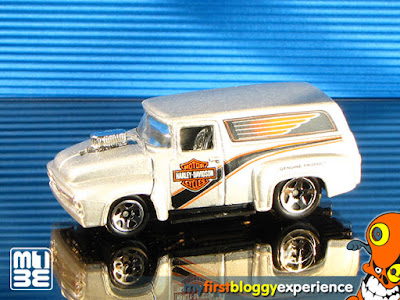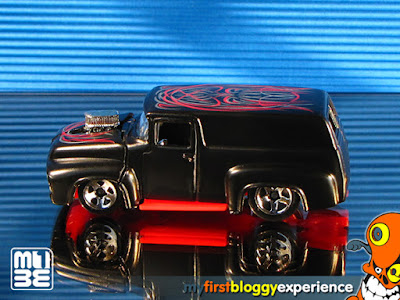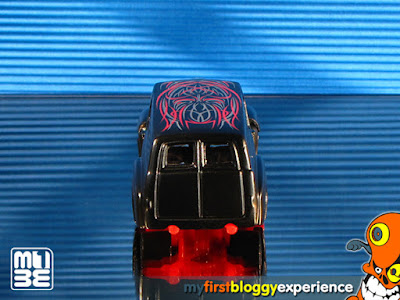
Durante los 50s, cuando las curvas reinaron supremas en el panorama completo del diseño, Ford se las arregló para crear un ícono para las próximas generaciones, tomando como base un vehículo que no fue concebido para ser una referente de estilo, más bien un referente de trabajo...
La segunda generación de la Serie F-100 fue introducida en 1953, con una revisión sustancial del diseño general que fue ofrecido para el modelo previo, haciendo más suaves todos los contornos y dando a este caballo de trabajo una apariencia más elegante...
Ahora, en esa época elegante no era un término adecuado para describir un vehículo utilitario, pero generaciones posteriores de entusiastas y coleccionistas de autos encontrarían que la clásica camioneta F-100 de los 50s, particularmente de la segunda generación, es simplemente elegante...
No en vano considero esta década una especie de Renacimiento en el campo del diseño, en este caso diseño industrial / automotriz y tal vez algunas personas estarán de acuerdo conmigo, pero mirando en retrospectiva, no hay otra década donde el diseño fuera tan prominente como activo de cambio cultural que en los 50s.
Esta década vio actualizaciones anuales importantes en estilo, confort, calidad de manejo y desempeño para todos los productos de la industria automotriz, y las camionetas no fueron la excepción a esta regla, tú no ves semejante prodigalidad hoy en día.
Mientras que la mayoría de elementos en el diseño de la carrocería para esta generación de la F-100 sufrieron cambios mínimos y esa fue una decisión buena (no es sensato arreglar lo que no está roto), hubo al menos un par de ellos que recibieron atención con el fin de dar a este modelo un look fresco cada año...
Mis invitadas para esta publicación son parte de esta generación clásica de la Serie F y representan quizás la más amada de las cuatro interpretaciones hechas: la Camioneta Ford F-100 Van Panel Custom de 1956, una Camioneta Panel para Trabajo Liviano Clase 2a.
Precisamente, las curvas fueron esenciales para el halo de elegancia que este modelo exuda y fueron refinadas para 1956 en la parrilla frontal y el parabrisas envolvente, elementos que hacen esta F-100 aún más deseable que sus contrapartes de la misma generación.
Este hecho es aún más notable cuando estamos hablando de la variante van panel, ya que sus cifras de producción fueron más bajas y siendo un vehículo para negocio principalmente, es más bien difícil de encontrar una de ellas en excelente condición, haciéndolas muy buscadas...
Para mis visitantes regulares no es un secreto que prefiero, por lejos, lanzamientos más antiguos y diseñadores de la vieja escuela con respecto a Hot Wheels, también deberían saber que hay razones concretas detrás de dicha decisión así que está lejos de ser un capricho mío...
No me malinterpretes, no es que ignore / desprecie la oferta actual y el trabajo de diseñadores de la nueva escuela en la marca azul de Mattel, NO, sería incongruente y miope de mi parte, siendo yo mismo un coleccionista observador y diseñador (gráfico); pero sería majadero de parte de alguien que se toma el tiempo de revisar la historia de esta marca y compara productos más antiguos con los nuevos, reclamar que Hot Wheels se está poniendo mejor con el tiempo simplemente porque sí.
También es ingenuo pasar por alto el hecho que la política de recorte de costos de esta marca está llegando a ser más incisiva con el tiempo, echando a perder el producto a los ojos de los coleccionistas e incluso a los ojos de los niños, por tanto, hay características que podías ver en productos viejos de la Línea Principal, que no verás de nuevo, porque el dinero manda y la mayoría de ejecutivos en HW ya no se sienten "demasiado generosos"...
Mis invitadas para esta reseña son una de las muchas pruebas contundentes en ese respecto, así que permíteme introducirlas brevemente.
Las conseguí con la ayuda de dos amigos míos, colegas coleccionistas e importadores (mercado secundario), en un lapso de más o menos 2 años, la última hace casi 5 años.
La ’56 Ford, también conocida como 1956 Ford, ’56 Ford F-100, ’56 Ford Truck o ’56 Ford F-100 Panel, fue diseñada por Phil Riehlman (de la Vieja Escuela) e introducida para las Líneas Principales en 1999; con al menos 57 iteraciones, incluyendo variaciones, puedes apostar que es un modelo deseable entre coleccionistas y muy popular; no es algo casual, obviamente.
Este modelo es más bien pesado, se siente sustancial en la mano, incluso las versiones con chasis plástico, porque tiene una buena dosis de diecast, fue rebajada y personalizada moderadamente, lo que está bien para mí, pero hay algo más: el artículo ofrece apertura de capó que se voltea hacia adelante, lo cual la hace una de las excepciones para la "regla de las 4 partes" convenientemente auto-impuesta por Hot Wheels.
Si esperas ver esta clase de características en la Línea Principal actual, estás demente, por eso es que en la versión reciente el capó fue sellado y si quieres esta característica de regreso, deberías prepararte para darle un golpe a tu billetera, porque solo en líneas Adultas y De Lujo están disponibles y el rango de precio es bastante diferente.
Conseguí 6 para mi colección, gracias a DIOS, dos de ellas de líneas Adultas y el resto de la Línea Principal; una de ellas representa la versión de capó sellado, el resto ofrece apertura de capó, también solo una de ellas ofrece construcción completa en diecast; hay trabajos de pintura diferentes y me encantan la mayoría de ellos, pero el que me gusta menos es precisamente el de la línea Adulta más reciente: Serie Nostalgic Brands: Hanna-Barbera (The Flintstones) de 2012.
Cuatro de ellas ofrece ventanas transparentes, una de ellas tintadas en verde oliva y la última tintada en amarillo; los interiores para dos de ellas son dorado cromado, el resto son cromados; la selección de ruedas es bastante pareja, con dos modelos ofreciendo ruedas multiparte con diseño de rimes Deep Dish Real Riders, una de ellas en dorado cromado, la otra con acabado cromado y White Wall (ambas con llantas labradas en caucho) y el resto con diseño de rimes 5 Spoke ya sea con acabado dorado cromado o cromado; dos de ellas fueron hechas en Tailandia, dos en China y dos en Malasia...
Jua 8:3-11 "Entonces los escribas y los fariseos le trajeron una mujer sorprendida en adulterio; y poniéndola en medio, le dijeron: Maestro, esta mujer ha sido sorprendida en el acto mismo de adulterio. Y en la ley nos mandó Moisés apedrear a tales mujeres. Tú, pues, ¿qué dices? Más esto decían tentándole, para poder acusarle. Pero JESÚS, inclinado hacia el suelo, escribía en tierra con el dedo. Y como insistieran en preguntarle, se enderezó y les dijo: el que de vosotros esté sin pecado sea el primero en arrojar la piedra contra ella. E inclinándose de nuevo hacia el suelo, siguió escribiendo en tierra. Pero ellos, al oír esto, acusados por su conciencia, salían uno a uno, comenzando desde los más viejos hasta los postreros; y quedó solo JESÚS, y la mujer que estaba en medio. Enderezándose JESÚS, y no viendo a nadie sino a la mujer, le dijo: mujer, ¿dónde están los que te acusaban? ¿Ninguno te condenó? Ella dijo: ninguno, SEÑOR. Entonces JESÚS le dijo: ni yo te condeno; vete, y no peques más."
ENGLISH
During the 50s, when curves reigned supreme in the whole design panorama, Ford managed to create an icon for the next generations, taking as basis a vehicle that was not conceived to be a referent of style, rather a referent of work...
The second generation of the F-100 Series was introduced in 1953, with a substantial revision of the overall design that was offered for the previous model, making all contours smoother and giving this workhorse a sleeker appearance...
Now, at that time elegant was not a suitable term to describe an utilitarian vehicle, but later generations of car enthusiasts and collectors would find that a classic F-100 truck of the 50s, particularly from the second generation, is just sleek...
Not in vane I consider this decade a sort of Renaissance in the field of design, in this case industrial / automotive design and maybe some people would agree with me, but looking in retrospective, there is no other decade where design were so prominent as a cultural change asset than the 50s.
This decade saw important yearly updates in styling, comfort, driving quality and performance for all the products of the automotive industry, and trucks were no exception to this rule, you don’t see such a prodigality nowadays.
While most elements in the body design for this F-100 generation underwent minimal changes and that was a sound decision (is not sensible to fix what’s not broken), there were at least a pair of them that received attention in order to give this model a fresh look each year...
My guests for this publication are part of this classic generation of the F-Series and represent perhaps the most beloved of the four renditions made: the 1956 Ford F-100 Panel Van Truck Custom, a Light Duty Class 2a Panel Truck.
Precisely, curves were essential for the halo of elegance that this model exudes and they were refined for 1956 in the front grille and the wrap-around windshield, elements that make this F-100 even more desirable than its counterparts of the same generation.
This fact is even more remarkable when we are talking about the panel van variant, since its production figures were lower and being a vehicle for business mainly, it’s rather hard to find one of them in excellent condition, making them highly sought after...
For my regular visitors is not a secret that I prefer, by far, older releases and old school designers regarding Hot Wheels, also they should know that there are concrete reasons behind such decision so it’s far from being a whim of mine...
Don’t get me wrong, it’s not that I ignore / despise the current offer and the work by new school designers in the blue brand of Mattel, NO, it would be incongruous and nearsighted on my part, being myself an observer collector and (graphic) designer; but it would be silly from someone who takes the time to check the history of this brand and compares older products with the new ones, to claim that Hot Wheels is getting better over time just because.
It’s also naive to overlook the fact that the cutting costs policy of this brand is becoming more trenchant over time, spoiling the product in the eyes of collectors and even in the eyes of kids, hence there are features that you could see in older products from the Mainline, that you will not see again, because money rules and most executives in HW don’t feel "too generous" anymore...
My guests for this review are one of the many compelling evidence in that regard, so let me introduce them briefly.
I got them with the help of two friends of mine, fellow collectors and importers (secondary market), in a span of pretty much 2 years, the last one almost 5 years ago.
The ’56 Ford, also known as 1956 Ford, ’56 Ford F-100, ’56 Ford Truck or ’56 Ford F-100 Panel, was designed by Phil Riehlman (from the Old School) and introduced for the Mainlines in 1999; with at least 57 iterations, including variations, you can bet is a desirable model among collectors and very popular; it’s not something casual, obviously.
This model is rather heavy, it feels substantial in the hand, even the versions with plastic chassis, because it has a good dose of diecast, it was lowered and moderately customized, which is fine for me, but there is something else: the item offers opening hood that flips forward, which makes it one of the exceptions for the conveniently self-imposed "4 parts rule" by Hot Wheels.
If you expect to see this kind of features in the current Mainline, you’re nuts, that’s why in the recent version of this model the hood was sealed and if you want this feature back, you should get ready to give your wallet a blow, because only in Adult and Deluxe lines are available and the price range is quite different.
I got 6 for my collection, thank GOD, two of them from Adult lines and the rest from the Mainline; one of them represents the sealed hood version, the rest offer opening hood, also, only one of them offer full diecast construction; there are different paint jobs and I love most of them, but the one I like the least is precisely the one from the most recent Adult line: 2012 Nostalgic Brands: Hanna-Barbera (The Flintstones) Series.
Four of them offer clear windows, one of them olive green tinted and the last one yellow tinted; the interiors for two of them are golden chrome, the rest are chrome; the wheels selection was quite even, with two models offering multipart wheels with Deep Dish Real Riders rims design, one of them in golden chrome, the other with chrome finishing and white wall (both with styled rubber tires) and the rest with 5 Spoke rims design in either golden chrome or chrome finishing; two of them were made in Thailand, two in China and two in Malaysia...
Joh 8:3-11 "And the scribes and Pharisees brought unto him a woman taken in adultery; and when they had set her in the midst, they say unto him: Master, this woman was taken in adultery, in the very act. Now Moses in the law commanded us, that such should be stoned: but what sayest thou? This they said, tempting him, that they might have to accuse him. But JESUS stooped down, and with his finger wrote on the ground, as though he heard them not. So when they continued asking him, he lifted up himself, and said unto them: he that is without sin among you, let him first cast a stone at her. And again he stooped down, and wrote on the ground. And they which heard it, being convicted by their own conscience, went out one by one, beginning at the eldest, even unto the last: and JESUS was left alone, and the woman standing in the midst. When JESUS had lifted up himself, and saw none but the woman, he said unto her: woman, where are those thine accusers? hath no man condemned thee? She said: no man, LORD. And JESUS said unto her: neither do I condemn thee: go, and sin no more."











































































.jpg)






















2 comments:
No offense but the design kind looks like flatten bread which pretty adorable.. I like the way how the bonnet opens. It’s unique.
Remember those younger days when miniature car was packed with die-cast and the durable paint, lead paint I supposed. Not to healthy but cool. Even the recent G1 Optimus Prime reissue looks too plastic IMHO.
No offense there pal, actually the roof in this panel van truck was chopped and since the overall design is quite curvy, it could look like a sort of bread, HEHE... Well, lead paint was something that had to be changed and it’s very welcome, but diecast toys used to have, you know, a good dose of diecast and nowadays there is plastic instead, lots of it, which takes away most of their charm and all their essence... Besides, previously diecast manufacturers and well as manufacturers of other kind of collectibles, used to be more generous with us; currently, they’re very petty minded and greedy... Uhmmm, at least there are still many options to enjoy our hobby with good collectibles...
Post a Comment